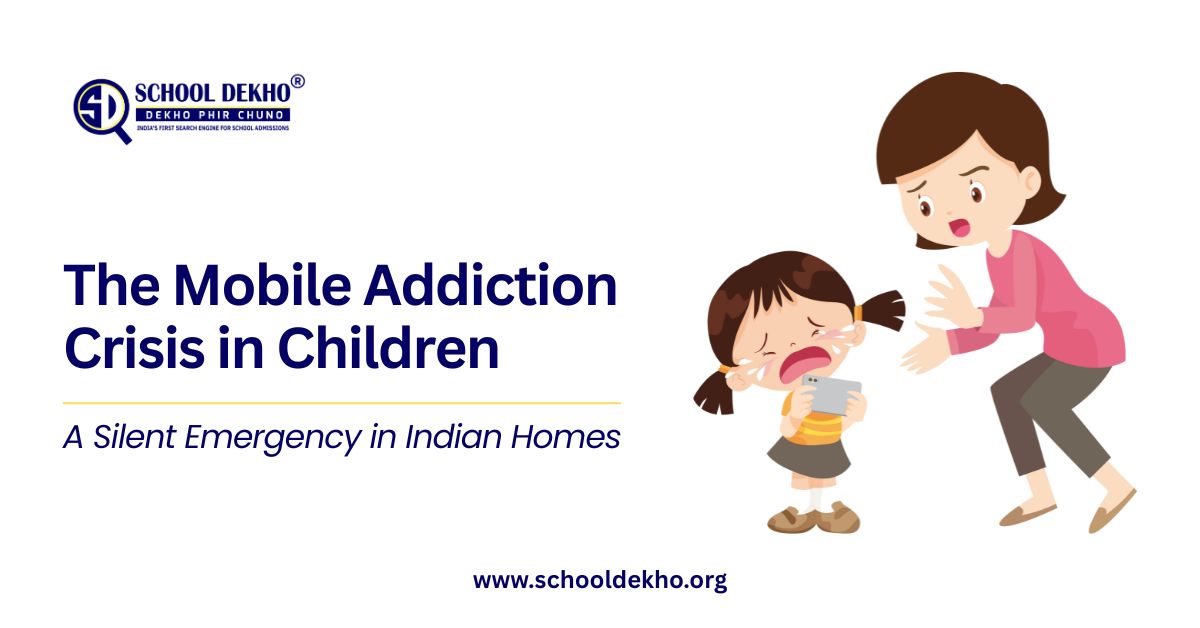Smartphones are shaping childhood more than parents. Unless we act—with discipline, play, and screen-free learning—we risk raising a generation that is restless, isolated, and dependent on screens for comfort.
It starts innocently enough. Evening time, homework done. Your child looks up with hopeful eyes:
Maa, just 15 minutes of mobile, please.
You’re tired, you agree. And just like that, mobiles become the ultimate reward. Multiply this across millions of homes, and we have a national emergency no one is loudly talking about.
Mobile Addiction in Children: How Bad Is It?
The problem is not just “kids spending time on phones.” It’s that phones are replacing childhood itself.
- As babysitters, Parents hand mobiles to keep children quiet.
- As pacifiers – Used to stop crying or make kids eat.
- As substitutes for play, Outdoor games have been replaced with YouTube or Roblox.
Key Data (India & Global):
- AIIMS Raipur (2022) – Children under 5 spend 2.22 hours daily on screens, double the WHO’s safe limit.
- WHO Guidelines – No screen time for under-2s, max 1 hour/day for ages 2–5.
- UNICEF 2023 Report – Indian teens spend an average of 7.3 hours/day on screens (including study + leisure).
- NIMHANS Bengaluru – Rising referrals of children with gaming disorder, social withdrawal, and screen dependency.
- Indian households – With 85.5% smartphone penetration and 800M+ internet users, exposure starts earlier than ever.
What Happens When Children Spend Too Much Time on Screens?
Doctors, teachers, and psychologists are raising red flags:
Physical Health:
- Disturbed sleep cycles due to blue light exposure.
- Early myopia (short-sightedness) and digital eye strain.
- Sedentary lifestyles → obesity & weaker immunity.
Mental & Emotional Health:
- Shorter attention spans (teachers report kids can’t sit through class).
- Irritability, restlessness, and even withdrawal symptoms when devices are taken away.
- Anxiety, loneliness, and in severe cases, depression are linked to social media use.
Developmental Delays:
- Speech delay in toddlers exposed to mobiles during meals.
- Limited imagination & creativity because YouTube replaces storytelling.
- Lack of problem-solving skills—games reward instant gratification, not patience.
In 2024, the Indian Academy of Paediatrics issued a strong advisory urging parents to strictly limit early screen exposure, calling it a “public health concern.”
Parents, the First Role Models
Here’s the hardest truth: your screen time is your child’s screen time.
Children learn more by imitation than by instruction. If you:
- Scroll during dinner, they’ll demand the same.
- Sleep with Netflix running, they’ll see it as normal.
Takeaway: If parents want digital discipline, they must practice it themselves.
Practical Solutions for Parents
Parents often ask, “Do I have to ban mobiles completely?”
Not at all. The key is structured use and meaningful alternatives.
1. Redefine Rewards
“Finish homework = 30 minutes mobile.”
“Finish homework = 30 minutes badminton with me.”
2. Introduce Screen Coupons
Give 30 minutes of screen time coupons daily. Once used, that’s it. Teaches budgeting.
3. Make Boredom Normal
Carry comics, puzzles, or colouring kits when travelling. Play Antakshari, word games, and riddles instead of handing over phones.
4. Enforce No-Phone Zones
Dining table, bedroom, and study desk = phone-free zones for the whole family.
5. Family Digital Detox Hour
Pick one hour daily when all devices are off. Do chores, play board games, or simply chat.
6. Use Technology Wisely
Install parental control apps. Track usage reports with your child—let them see the numbers.
7. Create Alternatives Beyond Screens
Offer a choice: “mobile time or outdoor cycling?” Once real-world fun becomes an option, dependence reduces.
Why Mobile-Free Preschools Are the Future
Addiction often starts before age 5—when toddlers are handed phones to eat or stay quiet. This wires their brains to equate screens with comfort and reward.
That’s why India urgently needs mobile-free preschools—where children learn through play, stories, and social interaction instead of digital devices.
Research Insight:
A Harvard University study (2021) showed children in play-based, screen-free preschools had better attention spans, emotional regulation, and social skills compared to peers with early gadget exposure.
Curio Nest International Preschool & Daycare: A Model for Screen-Free Learning
One inspiring example is Curionest International Preschool & Daycare, leading a quiet revolution in early childhood education.
Their guiding belief: children don’t need mobiles when real-life play is more exciting.
Here’s how they implement it:
- Nature Corners – gardening, butterflies, sandpits for sensory exploration.
- Role-Play Rooms – mini supermarkets, kitchens, doctor clinics—kids copy real life, not cartoons.
- Storytelling Circles – building imagination without YouTube.
- Sensory Labs – clay, water play, crafts, and even simple cooking.
- Movement & Traditional Games – yoga, kho-kho, kabaddi to build agility & teamwork.
- Digital Detox Certificates – children proudly showcase mobile-free achievements.
Most importantly, Curionest runs on a zero-screen policy—teachers and students alike. The results? Children are happier, healthier, and more socially confident.
The Play Revolution India Needs
This is not a future problem—it’s happening right now. If ignored, we’ll raise a generation that is physically weak, emotionally fragile, and socially isolated.
But change is possible:
- Parents can lead by example.
- Schools can build healthier boundaries.
- Preschools like Curionest can model what screen-free learning looks like.
It’s time India proudly declares: “No to mobiles, yes to play.”
Because in the end, one timeless truth remains: Your digital life shapes your child’s digital life.




